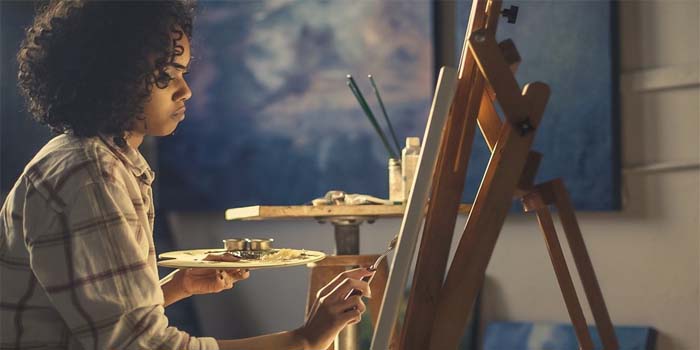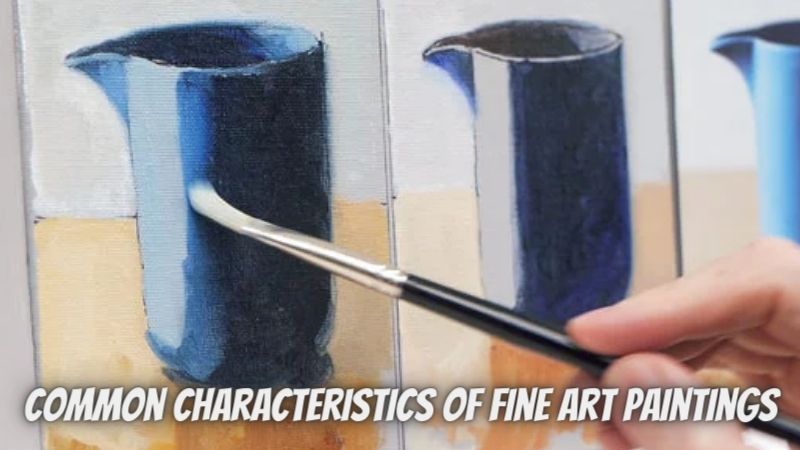Fine art is something created for aesthetic or intellectual value rather than a practical purpose. Creative expressions have grown and evolved just like the cultures and societies that have produced each new generation of artists.
To explain the history of fine art, we will follow a chronological timeline. For each timeline we will look at the defining characteristics of the most widely known art movements.
Cave Painting
The oldest known non-figurative cave painting is a red hand stencil in Maltravieso cave. It is believed to be made by Neanderthals over 64,000 years ago. The oldest figurative cave painting, a depiction of a bull, dates back over 40,000 years ago.
These cave paintings most often depicted large animals, tracings of human hands, and abstract patterns. Some historians believe that hunters painted their prey in order to capture their spirits for better success on the hunt.
Whether for artistic expression, ceremonial ritual, or some other purpose, these early visuals were the first raw style of painting, and their influence can be traced into the roots of Western and Eastern artistic styles.
Pre-Renaissance
In the late 14th century, Northern Europe produced Gothic art, which is an art movement rooted in religious devotion. It is known especially for the curved structure of its temples, its recolored glass, and its enlightened original copies.
Originating from the Byzantine Empire, Byzantine art focused on the needs of the orthodox church. The most lasting artworks from this period are the icons which continue to decorate churches around the world today.
Cave paintings grew to stone carvings and eventually sculptures and architecture; simple jewellery grew into patterned mosaics and stained glass. As human civilizations grew, the mediums for expression grew as well.
Renaissance
In the early Renaissance period, artists broke away from the traditional Byzantine art style and focused on creative and intellectual activity. Art in the early 15th century began to emphasize the beauty of humanity and the human form. This realism, also called Naturalism, was a celebration of the natural world and marked by a reverence for beauty and wonder.
Renaissance art emphasized individuals, and their unique characteristics outside of a group. DaVinci’s Mona Lisa, with her cryptic, knowing smile, is a prime example of the close emphasis on an individual. It also showcases the use of depth and texture to give perspective in ways that earlier styles did not.
Beyond individualism and depth of perspective, art of this period can be identified by the emphasis on nature and the natural world. A celebration of anatomy and the beauty of the human form and a resurgence of classical influences such as Greek and Roman gods.
Find here : Italian Elegance: A Journey through Art, Architecture, and Cuisine
Realism Reinvented
Fast forward to the early 19th century, artists tried to capture realistic unglamorized paintings and etchings of urban street scenes. A clashing between innocence and the often-horrifying realities of the developing world. Industrialization brought new advances in science and technology, but also pollution, crowded cities, and shocking living conditions for much of the population.
Realists of this time period rejected Romantic notions of the individual’s vast, emotional capacity to be God and artist alike. The emphasis shifted to real depiction of ordinary, contemporary people without glamorizing or shying away from the hardships.
Modernism
In the late 19th century, artists wanted to break away from traditional and classical art forms. This brought forward many new art movements. Most notably, Expressionism, Surrealism, Abstract Expressionism, Pop Art, and Photorealism
Expressionism exhibits the inner state of an artist with the use of colors and textures in two-dimensional space, along with abstract but clearly identifiable shapes. Expressionism shows the emphasis of emotion and colorful expression, the importance of brushstrokes to create texture and rhythm within the work, and the shift in portraying reality with distorted, exaggerated shapes.
Surrealism is characterized by imagery from the subconscious mind and it is used without the intent of the work being logically comprehensible. Dreamy, symbolic visuals, like Salvador Dali’s famous The Persistence of Memory with its drooping, melted clocks across a barren landscape. This type of dreamy symbolism actively rejected not only principles of realism, but of reality.
Abstract Expressionism allows the artists to express themselves with the use of shapes and colors. There are no actual objects present; it is non-representational art.
Pop Art is a celebration of consumerism, bold use of colors, and screen-printing techniques. Regular wellsprings of symbolism incorporate buyer item bundling, big name photos,, promotions, and comic strips.
The goal of Photorealism is to recreate photographs in a different medium, like paint or charcoal. Especially in an age consumed by digital media, the challenges of photorealism lie in the detail, light, colors, and shading to create the illusion that a sketch, painting, or mixed-medium work is actually a photograph.
The ongoing craft
This article is a short walk along the artworlds timeline and an overview of some of the important art movements. It is by no means comprehensive, but instead is meant to provide a high-level overview of the progression in the art world. It is clear that society will always find ever-evolving ways to express themselves. One can’t help but wonder what the next original art movement will be.




